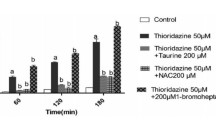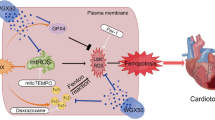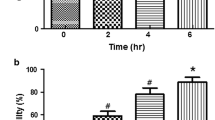Abstract
The generation of a reactive nitrenium ion by microsomal/mitochondrial cytochrome P450 (CYPs) from clozapine (CLZ) has been suggested as the main cause of cardiotoxicity by this drug. Previous studies indicated that thymoquinone (TQ) as an active constituent of Nigella sativa has pharmacological effects such as antioxidant, reactive oxygen species (ROS) scavenger, and inhibitory effect on CYPs enzymes. Therefore, we hypothesized that TQ with these pharmacological effects can reduce CLZ-induced toxicity in isolated cardiomyocytes and mitochondria. Rat left ventricular cardiomyocytes and mitochondria were isolated by collagenase perfusion and differential centrifugation respectively. Then, isolated cardiomyocytes and mitochondria were pretreated with different concentrations of TQ (1, 5, and 10 μmol/l) for 30 min and then followed by exposure to CLZ (50 μmol/l) for 6 h. After 6 h of incubation, using biochemical evaluations and flow cytometric analysis, the parameters of cellular toxicity including cytotoxicity, the level of oxidized/reduced glutathione (GSH/GSSG), malondialdehyde (MDA), reactive oxygen species (ROS) formation, lysosomal membrane integrity, mitochondria membrane potential (ΔΨm) collapse, and mitochondrial toxicity including succinate dehydrogenase (SDH) activity and mitochondrial swelling were analyzed. We observed a significant toxicity in isolated cardiomyocytes and mitochondria after exposure with CLZ which was related to ROS formation, oxidative stress, GSH depletion, lysosomal and mitochondrial damages, and mitochondrial dysfunction and swelling, while TQ pretreatment reverted the above toxic effect of CLZ on isolated cardiomyocytes and mitochondria. Our results indicate that TQ prevents and reverses CLZ-induced cytotoxicity and mitochondrial damages in isolated cardiomyocytes and mitochondria, providing an experimental basis for clinical treatment on CLZ-induced cardiotoxicity.





Similar content being viewed by others
Data availability
Not applicable.
References
Abdel Hamid OI, Ahmed MG, Hassaneine HM, Rashed HE (2017) Evaluation of the role of captopril on clozapine-induced cardiotoxicity and hematotoxicity in adult male albino rats. Toxicol Res Appl 1:2397847317696539
Ahmad S, Beg ZH (2013) Elucidation of mechanisms of actions of thymoquinone-enriched methanolic and volatile oil extracts from Nigella sativa against cardiovascular risk parameters in experimental hyperlipidemia. Lipids Health Dis 12:86
Albassam AA, Ahad A, Alsultan A, Al-Jenoobi FI (2018) Inhibition of cytochrome P450 enzymes by thymoquinone in human liver microsomes. Saudi Pharm J 26:673–677
Alberich S, Fernández-Sevillano J, González-Ortega I, Usall J, Sáenz M, González-Fraile E, González-Pinto A (2019) A systematic review of sex-based differences in effectiveness and adverse effects of clozapine. Psychiatry Res 280:112506
Arzuk E, Karakuş F, Orhan H (2021) Bioactivation of clozapine by mitochondria of the murine heart: possible cause of cardiotoxicity. Toxicology 447:152628
Atkin K, Kendall F, Gould D, Freeman H, Lieberman J, O’Sullivan D (1996) Neutropenia and agranulocytosis in patients receiving clozapine in the UK and Ireland. Br J Psychiatry 169:483–488
Badary OA, Taha RA, Gamal El-Din AM, Abdel-Wahab MH (2003) Thymoquinone is a potent superoxide anion scavenger. Drug Chem Toxicol 26:87–98
Bradford MM (1976) A rapid and sensitive method for the quantitation of microgram quantities of protein utilizing the principle of protein-dye binding. Anal Biochem 72:248–254
De Berardis D et al (2012) Update on the adverse effects of clozapine: focus on myocarditis. Curr Drug Safety 7:55–62
Dragovic S, Boerma JS, van Bergen L, Vermeulen NP, Commandeur JN (2010) Role of human glutathione S-transferases in the inactivation of reactive metabolites of clozapine. Chem Res Toxicol 23:1467–1476
Dragovic S, Gunness P, Ingelman-Sundberg M, Vermeulen NP, Commandeur JN (2013) Characterization of human cytochrome P450s involved in the bioactivation of clozapine. Drug Metab Dispos 41:651–658
Dur A, Kose H, Kocyigit A, Kocaman O, Ismayilova M, Sonmez FC (2016) The anti-inflammatory and antioxidant effects of thymoquinone on ceruleine induced acute pancreatitis in rats. Bratisl Lek Listy 117:614–618
Farkhondeh T, Samarghandian S, Borji A (2017) An overview on cardioprotective and anti-diabetic effects of thymoquinone. Asian Pac J Trop Med 10:849–854
Khalife K, Lupidi G (2008) Reduction of hypervalent states of myoglobin and hemoglobin to their ferrous forms by thymoquinone the role of GSH, NADH and NADPH. Biochim Biophys Acta 1780:627–637
Khezri S, Sabzalipour T, Jahedsani A, Azizian S, Atashbar S, Salimi A (2020) Chrysin ameliorates aluminum phosphide-induced oxidative stress and mitochondrial damages in rat cardiomyocytes and isolated mitochondria. Environ Toxicol 35:1114–1124
Kilian JG, Kerr K, Lawrence C, Celermajer DS (1999) Myocarditis and cardiomyopathy associated with clozapine. The Lancet 354:1841–1845
Liu H, Liu HY, Jiang YN, Li N (2016) Protective effect of thymoquinone improves cardiovascular function, and attenuates oxidative stress, inflammation and apoptosis by mediating the PI3K/Akt pathway in diabetic rats. Mol Med Rep 13:2836–2842
Longhi S, Heres S (2017) Clozapine-induced, dilated cardiomyopathy a case report. BMC Res Notes 10:1–3
McGill MR, Jaeschke H (2013) Metabolism and disposition of acetaminophen: recent advances in relation to hepatotoxicity and diagnosis. Pharm Res 30:2174–2187
Meltzer HY et al (2003) Clozapine treatment for suicidality in schizophrenia: international suicide prevention trial (InterSePT). Arch Gen Psychiatry 60:82–91
Nagi MN, Mansour MA (2000) Protective effect of thymoquinone against doxorubicin–induced cardiotoxicity in rats: a possible mechanism of protection. Pharmacol Res 41:283–289
Odinokova I et al (2018) Effect of melatonin on rat heart mitochondria in acute heart failure in aged rats. Int J Mol Sciences 19:1555
Orhan H (2015) Extrahepatic targets and cellular reactivity of drug metabolites. Curr Med Chem 22:408–437
Salimi A, Motallebi A, Ayatollahi M, Seydi E, Mohseni AR, Nazemi M, Pourahmad J (2017) Selective toxicity of persian gulf sea cucumber holothuria parva on human chronic lymphocytic leukemia b lymphocytes by direct mitochondrial targeting. Environ Toxicol 32:1158–1169
Samarghandian S, Azimini-Nezhad M, Farkhondeh T (2016) The effects of Zataria multiflora on blood glucose, lipid profile and oxidative stress parameters in adult mice during exposure to bisphenol. Cardiovasc Hematol Disord Drug Targets 16:41–46
Shi W, Deng H, Zhang J, Zhang Y, Zhang X, Cui G (2018) Mitochondria-targeting small molecules effectively prevent cardiotoxicity induced by doxorubicin. Molecules 23:1486
Shukla SK, Gupta S, Ojha SK, Sharma SB (2010) Cardiovascular friendly natural products: a promising approach in the management of CVD. Nat Prod Res 24:873–898
Silva SG, F, F Simoes R, Couto R, J Oliveira P, (2016) Targeting mitochondria in cardiovascular diseases. Curr Pharm Des 22:5698–5717
Stelmashook E, Chetverikov N, Golyshev S, Genrikhs E, Isaev N (2020) Thymoquinone induces mitochondrial damage and death of cerebellar granule neurons. Biochemistry (Moscow) 85:205–212
Williams DP, O’Donnell CJ, Maggs JL, Leeder JS, Uetrecht J, Pirmohamed M, Park BK (2003) Bioactivation of clozapine by murine cardiac tissue in vivo and in vitro. Chem Res Toxicol 16:1359–1364
Funding
This study was supported by Shahid Beheshti University of Medical Sciences, Deputy of Research.
Author information
Authors and Affiliations
Contributions
A.A. and A.S. conceived and designed research. S.K. and Z.J. conducted experiments. A.S. contributed new reagents or analytical tools. A.S. analyzed data. A.S. and A.A. wrote the manuscript. All authors read and approved the manuscript and all data were generated in-house and that no paper mill was used.
Corresponding author
Ethics declarations
Ethical approval
This research was approved by the Ethics Committee at the Shahid Beheshti University of Medical Sciences, Tehran, Iran. The approval code is IR.SBMU.RETECH.REC.1399.494.
Consent to participate
All authors have given consent to their contribution.
Consent to publish
All authors have agreed with the content and all have given explicit consent to publish.
Competing interests
The authors declare no competing interests.
Additional information
Publisher's note
Springer Nature remains neutral with regard to jurisdictional claims in published maps and institutional affiliations.
Supplementary Information
Below is the link to the electronic supplementary material.
Rights and permissions
About this article
Cite this article
Hafez, A.A., Jamali, Z., Khezri, S. et al. Thymoquinone reduces mitochondrial damage and death of cardiomyocytes induced by clozapine. Naunyn-Schmiedeberg's Arch Pharmacol 394, 1675–1684 (2021). https://doi.org/10.1007/s00210-021-02095-1
Received:
Accepted:
Published:
Issue Date:
DOI: https://doi.org/10.1007/s00210-021-02095-1




